#wallachian social classes
Explore tagged Tumblr posts
Text

A question that doesn't come up often enough: Where's the rest of Trevor's family?
We know the entire Belmont line was almost completely annihilated in a mob, but the series is pretty vague on how many people were actually living in the house. With a high mortality of the medieval period, families were often big and with an occupation as dangerous as hunting monsters, the Belmonts were probably no different. This was very much a 'survival of the fittest' and 'heir and plenty of spares' mentality.
Trevor lost his family at twelve, so it's very unlikely he was the only sibling. But even in the event his parents were extremely unfortunate and he was their only surviving child, the multiple siblings theory still applies to the previous generations.
So his immediate family was killed. What about the extended family?

In Lament of Innocence, Leon Belmont was a French baron, but he gave up his land and titles to rescue Sara. Following the storyline of the Netflix series, he then chased Dracula east and neither the games nor series ever mention what became of him other than the fact he fathered the entire bloodline.
Based on the games, it would be safe to assume the Belmonts are not part of the aristocracy, but as far as the series goes, they are mentioned as one of Wallachia's 'great houses' in the first couple episodes. They're not unknown to the Wallachian people. Plus, the reigning Prince of Wallachia did have the power to invest anyone he chose with a noble title. The real Vlad the Impaler actually made use of this power by elevating members of the lower classes, effectively ensuring their loyalty through gratitude. (Because if he was overthrown, things weren't going to go well for the people who benefited from his rise to power.)
So it's not impossible that somewhere in the 400 years between Leon and Trevor, some Belmont won the favor of Wallachia's monarch and was rewarded with a boyar lord's title.
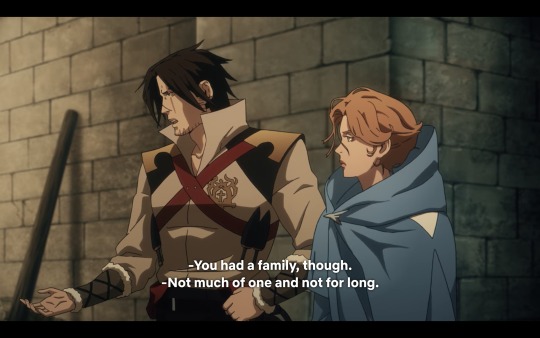
'Not much of a family and not for long' seems to indicate the line was already pretty diminished before the mob attacked.
Trevor only mentions his family a handful of times throughout the four seasons, and the only specific members that come up are his parents with the reference to his mother's books and the story of how his father had once gotten into a fight with a Speaker.
The only other time his parents come up is in Season 2 when Sypha asks if they were magicians, to which he answers no, but they knew a lot about magic. At the very least, this shows both of his parents were alive long enough for him to remember them. Otherwise, the story about the fight with the Speaker could have easily been told to him by another relative that had been looking after him while the books Trevor mentions that belonged to his mother could have just been part of the family's collection after she was long gone.
With some historical context (provided we adhere to accuracy,) this actually gives some insight to Trevor's childhood. He would have known his mother very well. Unlike many other European countries where the nobility left childrearing to a nurse and other staff, the education of a boyar's son in Wallachia was actually left to the women of the household. His mother would have likely overseen every part of his upbringing that wasn't physical combat training, which would have been his father's domain.
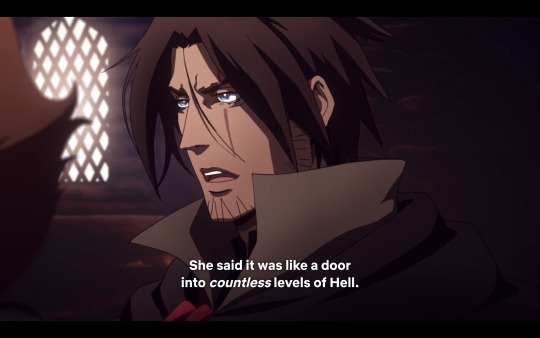
Another possibility worth exploring is his mother was the Belmont and his father was the one who married into the family. An unusual if not unheard of dynamic for the times, but the series does subtly imply the women of the family were as much of hunters as the men when Trevor talks about how only one member of his family encountered the Infinite Corridor. It's possible they could have adopted other more non-traditional roles for the times.
This also accounts for his complete lack of surprise in Episode 3 when 'the Elder's grandchild' turns out to be a granddaughter and again in Episode 4 when Sypha reveals herself as a mage.
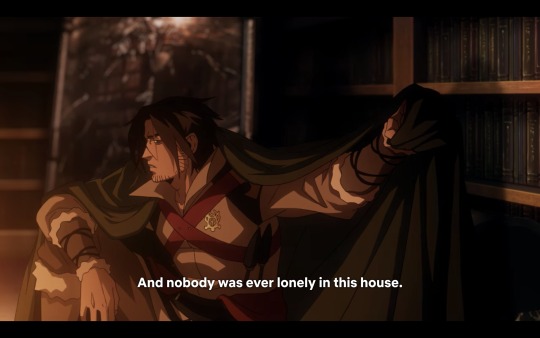
So we've established both of Trevor's parents were alive and well for a significant part of his early life. On to the extended family.
Unless the Belmonts were practicing Targaryen levels of incest (although marrying one's cousin was an accepted practice in this time,) Trevor should have had other relatives to rely on. Assuming the family had a traditional dynamic and his mother did indeed marry into the Belmont line, and since aristocrats generally married other aristocrats, her father would have been one of the boyar lords of the region. The same applies if his father had sisters who married into other families.
Given the primary goal of marriage in this time period was less romantic and more in the interest of forming alliances with other families for political or financial reasons, there could also be a wider family network among the nobility at play.

Side note: There's a small possibility he's distantly related to one or both of these two.
...
So what happened to those other relatives?
Personally, I think the answer to this question might play into the cynicism and bitterness of Trevor's character in general. If we explore the scenario that he did seek help from his mother's family, people who had no ties to the Belmonts other than the fact their sister/daughter married into the family, with the self-serving atmosphere of the Wallachian aristocracy at the time, I can imagine him being met with a cold reception.
And sadly, this would be an all too realistic situation for the times. As stated above, the boyars were corrupt. There wasn’t a clear hierarchy among the nobility (That is, Wallachia did not have the equivalent of dukes, earls, viscounts, etc.) so power was determined by wealth or land-owning. This rivalry for power went all the way to the top; Wallachia's throne changed hands once every couple years as the Dănești and Drăculești branches of the reigning family relentlessly fought over it.
In this minefield of political intrigue, the only surviving member of an otherwise shattered bloodline, especially a twelve year old excommunicate, would not have been of much use in the eyes of the nobility. With the Belmonts disgraced with heresy charges, neither branches of the reigning family would have been interested in their support and probably would have wanted to distance themselves from an alliance that could potentially damage their own reputation.
A public rejection from the Prince would have rebounded throughout the region and put the final nail in the coffin of what the Church started. None of the boyars would have been interested in helping Trevor, distant family or not. On the other hand, helping their orphaned and disgraced nephew/grandson is the Christian thing to do, but since Trevor and his murdered family are now enemies of the Church and out of favor with Wallachia's monarch, that 'help' might've extended only as far as, "We're deeply sorry for your circumstances. Here's some money, now get out."
So Trevor was born into one of the highest and most privileged classes in the region and is the product of literally generations of a family that has had two goals since Leon: protecting the world from Dracula and the destruction of Dracula. The night of the mob would have completely shattered a mentality he'd had since he was born. Throw that on top of that the trauma of losing one’s home and entire immediate family in a single night and then being vilified by both the people his family had protected and the wider circle of his extended family.
That is a brutal shift in world views for a twelve year old to handle, so it's easy to see why the series opens with him already burned up the anger and the grief over what happened and all that’s left for him is the aimless wandering, drinking, and getting into fights.

In all, this statement really summed up the beginning of his character arc perfectly.
#castlevania#trevor belmont#belmont family#sypha belnades#character analysis#castlevania headcanons#castlevania targoviste#character development#speakers#medieval wallachia#wallachian social classes#medieval romania#medieval history#medieval europe#wallachian politics#game of thrones reference
136 notes
·
View notes
Text
Characters played in TTRPGs since 2000
I'm reposting this to my gaming blog. I'm updating it and I'm also going to mark which ones I've got Hero Forge minis of. I probably won't catch them all, there've been a few games in the last 23 years.
Definitely didn't catch all of them, but here's quite a few.
Campaign
D&D 3.5
Angwiel - snake-person (elf mechanically) Sorcerer/Cleric
Jhessail Crackstone - wererat (hengeyokai mechanically) Paladin/Rogue
Kya'Rei L'Di'Shinabon - Drow Ranger/Cleric
Yroling Xian'ri - hengeyokai cleric
Teryna - human (reincarnated fox familiar) ranger
Medora - human sorcerer/disciple of Medusa (homebrew prestige class)
Lheru - hengeyokai (spider) druid
D&D 5e
Shui Baenre - half-drow Lore Bard acolyte (child of Liriel Baenre and Fyodor of Rasheman) - Phandelver
Aisha Yethtai - tiefling knight in silver battlemaster - Storm Giant's Thunder/Dragon Heist (Hero Forge mini exists)
Weary - tiefling monster slayer - Curse of Strahd (Hero Forge mini exists)
Zihu - Yuan-ti Celestial Warlock (ancient couatl) Acolyte - homebrew (Hero Forge mini exists)
Zohuital - Yuan-ti Celestial Warlock (lillend sisters) Hermit - homebrew
Ranveig - scourge aasimar soldier valor bard - homebrew (Hero Forge mini exists)
Kanti Messner - Changeling Lore Bard/Celestial Warlock (Book of Exalted Deeds) - homebrew (Hero Forge mini exists)
Aramis Hopps - Harengon Drunken Master/Mastermind Charlatan - homebrew
Caress Melani - Yuan-ti Ancients Paladin, Courtesan of Sharess - Phandelver/Hoard of Dragon Queen (Hero Forge mini exists)
Proper Ruin - Yuan-ti Battlesmith, Lyceum Scholar - Netherdeep, (Hero Forge mini exists)
Mariah the Blue - Variant Human Draconic Sorcerer city investigator
Nesali - yuan-ti archaeologist Beast Barbarian, full of anxiety and self-esteem issues - Candlekeep (Hero Forge mini exists)
Nishan Domine - yuan-ti mercenary Totem Barbarian, tranquil fury, battlefield redecoration
Teena Valle - halfling Inquisitive rogue... died to a vampire in one session
Karen Essakye - Seattle resident githyanki law student turned scout rogue stuck in Ravenloft
Pathfinder 1e
Ide Shika - Human Fighter/Chevalier - Rise of the Runelands (Hero Forge mini exists)
Ahriah - Tiefling Witch - Homebrew
Pathfinder 2e
Sevic Rasitoria - Fetchling Beastkin (Bat) - Swashbuckler (Gymnast), Anathema Vaults
Vihra of Charity - Vishkanya Scalekeeper, Witch (Faith's Flamekeeper), Season of Phoenix - Urban Fantasy merger of Season of Ghosts and Fist of the Ruby Phoenix
Fabula Ultima
Only - Rogue/Tinkerer/Wayfarer - An uplifted harpy trying to uplift her species.
Scion 1e
Sang-Yoon Koga - The Trickster Fox, Las Vegas magician, daughter of Susano'o.
Juri Como - Daughter of Benzaitan, The Great Mangaka, "Social Ninja", Expert at Obfuscating Stupidity (Hero Forge mini exists)
Delilah Samson - Child of Loki, shapeshifter, illusionist, ex-cop, private eye, assistant to Hel (in her guise as a mortal lawyer)
Sa - Dark avenger, brutal slayer of criminals. [redacted]
Scion 2e
Lily Watson - Child of Inari, brat, tomb raider, reckless and selfish
Hilde Sifgard - Child of Sif, youtube daredevil
City of Mist
Patricia Althius - war vet, PTSD, vampire vigilante, daughter to a family of war profiteers and generations of shady dealings. Rift of Count of Monte Cristo/Lamashtu (Hero Forge mini exists)
Random - lab rat, feral teen, Rift of the Movie Monster, non-binary and ace AF (Hero Forge mini exists)
Indira Yi - Rift of Arthur Dent, streaming journalist, improbably lucky.
Fate
Katrina Stnad/Voivode Valeria Draculesti/The Wallachian - doctor, martial artist, ex-terrorist. Steampunk/Dieselpunk game.
Irene Breholm - Divine Blood game, dhampir, sidhe, born to the Breholm Sorcerer family... kinda a big civilian dork in over her head.
Jocasta - Sorceress, librarian, daughter of a Greco-Japanese crime family who just wants out. Constantly getting kidnapped. (Hero Forge mini exists)
Hero System
Megumi Morisato, aka "Greyskin" - dimensional phaser, tank, really damn hard to bring down, geeky fangirl with lots of superhero historical knowledge and trivia. (Hero Forge mini exists)
Buffy the Vampire Slayer
Cadynce Baker / Nya'd'cebrac - demon of blessings and protection, one sister of a paired set of demons, her sister being the spear to her shield. Professional game designer. (Hero Forge mini exists)
BESM 3rd
The Wallachian - see Fate, that campaign started in BESM and moved to Strands of Fate later.
Himura Tai-Wen - NSFW campaign, oni lady with lots of girlfirends ended up ascending to higher plane of existence.
Water Tribe Swordsman whose name I forget in Avatar game
Shadowrun
Keina Isawa - Oni shinto magician, wanted to be an idol singer, ended up a shadowrunner instead. (Hero Forge mini exists)
Lacey Chambers - human adept (social/pistol) spy, burned (Hero Forge mini exists)
Leyti - Finnish Changeling (foxlady) mystic adept, bar owner, fixer. uncertain on the name
Legend of Five Rings - 4th Edition
Moto Hotaru - born a scorpion, trained a shinobi, married a unicorn, became a diplomat, died to the Kargat, but tricked them into doing things that scuttled their operations in the area.
Chronicles of Darkness
Emma Terreal - Sin-Eater/Geist, bank accountant suffocated in a bank vault during a robbery. (Hero Forge mini exists)
Suzume Armitage - A young woman unknowingly a creation of magic.
Annika Walsh - engineer working on the space elevator
Key 13 - (Shadowrun setting with CofD rules) street samurai with experimental soul-active implants.
Monster of the Week
Niamh Miller - The Searcher, a teenager on the swim team who experienced a cosmic insight and is now eager to explore the supernatural.
One-Shots/Short-Runs
Monster of the Week
Whisp, The Libram of Whispered Prayers - The Talisman, a sentient magical book who can take human form.
Persia Mason - The Changeling, a teenaged gorgon living at a secret agency for monitoring supernatural things. (Hero Forge mini exists)
D&D 5e
Meesha Canidae - Shifter Merchant Diviner, socially awkward but unaware of it. (Hero Forge mini exists)
Valaine the Morbid - Shifter Swarmkeeper Entertainer, a bat shifter with a swarm of bats she performs shows with
Yuina Kendrick - a bitchy jurogumo (custom lineage) from Urban Arcana who got stuck in Ravenloft... and deserved it.
Kori the Storyteller - dhampir Spirit Bard, a dreaming soul animating her comatose body.
Erased - Variant Human Sage Undying Warlock (angel of death), absent-minded scholar who accidentaly got her name erased from reality.
Eve Niah - Halfling Undying Warlock (amused lich) with a bone whip, weirdly very cheerful
Cael - wood elf gorgon sorceress, former servant with memory problems.
Mutants and Masterminds
Queen Snake - doctor, martial artist, ritual mage, awakened snake-like powers when an experimental treatment mixing magic and medicine was injected into her during a hostage event. (Hero Forge mini exists)
Masks
Serpent Princess - The Beacon, daughter of Queen Snake, very eager to be a great hero and huge flirt.
One-Ring
High elf sorceress pre-gen character, forget the name
Apocalypse World
Nameless - doctor and gunfighter with snake-like mutations, seeking revenge on the one who changed and maimed her.
Fight with Spirit
Maeve Dumas - born to a martial arts family, secretly part of a competitive dance team
6 notes
·
View notes
Text
PART 1: THE BASICS
What is your full name? A. Maria Rhea Renard Where and when were you born? A. Brasov, Wallachia. March 5th, 1779 Who are/were your parents? (Know their names, occupations, personalities, etc.) A. Laurent & Astoria Renard, father was a hunter that worked alongside the Belmonts. Mother worked as a seamstress. Laurent was stern, doting, well respected, loyal and protective. Astoria was loving, understanding, kind and generous. Do you have any siblings? What are/were they like? A. One sister, Annette. Kind, sweet, gentle, generous, affectionate, angelic. Where do you live now, and with whom? Describe the place and the person/people. A. Outside of Brasov, with Alucard. A lodge within the woods roughly five miles away from Richter & Annette’s home. What is your occupation? A. A huntress of monsters, mostly vampires. Hunts alongside both Richter & Alucard. Write a full physical description of yourself. You might want to consider factors such as: height, weight, race, hair and eye color, style of dress, and any tattoos, scars, or distinguishing marks. A. Maria stands around 5′6″ with her low heeled shoes she then stands at 5′8″, she possesses a curved figure weighing around 130lbs. She has long wavy golden locks and jade green eyes, she is not one for long frilly dresses. She prefers to sport a jacket dress with black shorts or leggings, low heeled shoes, leather gloves. Ears are pierced but earrings are simple emeralds. No tattoos mark her flesh, she has a few scars here and there on her body. And a small carnation birthmark on her inner hipline on the right side. To which social class do you belong? A. Middle Class, Wealth Status is Medium. Do you have any allergies, diseases, or other physical weaknesses? A. Slight allergy to nuts, no diseases ailing her. Physical weakness are a low, she’s pretty fit for her age. However, if she uses too much of her magic without taking time to recharge she overexerts herself and her stamina. Are you right- or left-handed? A. Right handed, but during her training with Richter she taught herself to use her left hand in case of injury. What does your voice sound like? A. Voice range is probably a low to high alto, with slight Wallachian accent. Energetic and vibrant. What words and/or phrases do you use very frequently? A. “I do not get into trouble. It follows me.” “I can handle this.” What do you have in your pockets? A. An owl feather, a pouch of money, spare ribbons, and a small knife. Do you have any quirks, strange mannerisms, annoying habits, or other defining characteristics? A. When bored, she hums or sings aloud. She fiddles with her hair bun often, plays with her hair. Nips and picks at the tips of her gloves when she’s thinking or trying to think of something. Annoying habits, can be a bit clingy. Rambles or rants when she’s trying to win an argument, she tends to stomp her foot when she’s getting angry or annoyed. A signature characteristic is she learned how to use her sash as if it were a whip, and sometimes uses it on Alucard when he tries to run off to brood after they get into a tiff.
4 notes
·
View notes
Link
As Always: text is provided only in the event of access expiration or post deletions from the hosting site. Whenever possible, always read the article at the link.
Vampires exist! A spooky Halloween post
From the Berkeley Blog, by Wadim Strielkowski | OCTOBER 29, 2018
Is everyone looking forward to the forthcoming Halloween? The “All Hallows Evening” is at our doorstep and everyone is preparing for trick-or-treating, brushing off their scary costumes, renting horror movies, carving pumpkins and generally intending to have fun.
Halloween is the holiday that originated from the Celtic rituals in Ireland and the United Kingdom only to be brought by the migrants to the United States to become an event that can now only be compared to Christmas when it comes to its business potential, overall sales, as well as its economic significance. Last year, American consumers spent about $9.1 billion on Halloween festivities. A paper published in 2017 claimed that the share of more “consumer-focused” Halloween products gradually increased over the years in relation to the share of more “traditional” products. And the most popular Halloween activity is wearing a spooky costume.
Vampires and Halloween
One of the most popular Halloween costumes is to dress up as a vampire. For some reason, people just love Dracula and others of his kind. There are many films, comics and popular literature on and about vampires. And you would be probably surprised to find out that vampires can actually exist and their existence does not contradict modern science!
Well, there are plenty blood-sucking animals found in nature, and even humans need to drink the blood from their own spices sometimes to survive. So, why cannot vampires (the creatures from the myths and legends, as we tend to think of them) exist too? Most scientists use simple math to prove that the existence of vampires is not possible. Their line of argumentation is the following: assume that a vampire needs to feed only once a month (we ignore the mortality rate, since it is irrelevant here). When this process occurs, another vampire is created. If the countdown starts in 1600 AD or some other time around that (on the 1st of January 1600 the world’s population was 536 870 911), then by February 1600 there would be two vampires (one who turned a human into vampire to start with and another one who was a human but became a vampire after the encounter with a vampire). In March 1600 there would be four vampires in existence, and in April 1600 – eight vampires. Therefore, some scientists say, each month the number of vampires doubles and after n months there are 2^n vampires which gives us a geometric progression with ratio 2.
As most of you might know, the geometric progression is increases at a very quick pace and if you sit with a pencil and paper and calculate it for our vampires example, you will arrive to the conclusion that after 30 months there would be no humans left – everyone would be turned into a vampire and the humanity would be wiped out by June 1602. Even if human birth rate is included into our calculations, it remains a very small fraction deaths caused by the vampires and would have prolonged the extinction of human race by just one month. Therefore, some scientists conclude, vampires cannot exist, since their existence contradicts the existence of human beings. This logical proof is of a type known “as reductio ad absurdum”, that is, reduction to the absurd.
However, if one starts digging dipper, everything is not that straightforward. Some works of fiction, Stephenie Meyer’s “Twilight series”, Charlaine Harris’s “Sookie Stockhouse (Southern Vampire) series”, “True Blood” (TV series) as well as Elizabeth Kostova’s “The Historian”, show the world where vampires peacefully co-exist with humans.
In Stephenie Meyer’s “Twilight series” vampires can tolerate the sunlight, interact with humans (even fall in love with them) and drink animals’ blood to survive. Of course, they have to live in secrecy and pretend to be human beings. In “True Blood” TV series, however, a world is shown where vampires and humans live side-by-side and are aware of each other. Vampires can buy synthetic blood of different blood types that is sold in bottles and can be bought in every grocery store, bar or gas station. They cannot walk during daytime, so they usually come out at night. Humans also find use of vampires’ essence – vampires’ blood (called “V”) is a powerful hallucinogenic drug that is sought by humans and traded on the black market (sometimes humans capture vampires with the help of silver chains or harnesses and then kill them by draining their blood). Some humans even seek sex with vampires (vampires are stronger and faster than humans and can provide superb erotic experience). There is a possibility to turn a human being into a vampire, but it takes time and effort.
Let us assume that at the time of the events described in the first book of the series, “Dead Until Dark” (2001), the world’s vampire hypothetical population was around five million (the population of the state of Louisiana in 2001 we arbitrarily use in our calculations). The initial conditions of what I call “a Harris-Meyer-Kostova model” are the following: five million vampires, 6 159 million people, there are organized groups of vampire “drainers”.
Simple calculations yield that the human population will be growing until 2046 when it reaches its peak of 9.6 billion people, whereupon it will be declining until 2065 until it reaches its bottom at 6.12 billion people. This process will repeat itself continuously. The vampire population will be declining until 2023 when it reaches its minimum of 289 thousand vampires, whereupon it will be growing until 2055 until it reaches its peak at 397 million vampires. This process will also repeat itself continuously and we will end up with a cyclical system of human-vampire co-existence.
Under certain conditions, the Harris-Meyer-Kostova model seems plausible and allows for the existence of vampires in our world. Peaceful co-existence of two spices is a reality. However, this symbiosis is very fragile and whenever the growth rate of human population slows down, the blood thirst of vampires accelerates, or vampire drainers become too greedy, the whole system lies in ruins with just one population remaining.
There are more interesting implications to this study: consider for example the organized groups of vampire hunters (“Buffy the Vampire Slayer”) or superhero vampire hunters (“Blade”). The results seem even more interesting and all clues lead to the one simple fact – vampires might co-habituate with humans and modern science cannot refute their existence! Here, you can download a poster explaining my research on this topic and covering different models of vampires and humans co-existence: Poster Vampires exist
Karl Marx, a vampire hunter
You would be surprised to learn that the works of Karl Marx are full of mentioning of vampires (Marx used the vampire metaphor at least three times in Capital). For example, in one of the cases Marx describes British industry as “vampire-like” which “could but live by sucking blood, and children’s blood too”. Here is another quote:““Capital is dead labour which, vampire-like, lives only by sucking living labour, and lives the more, the more labour it sucks”. Marx’s colleague and long-time sponsor Frederick Engels also used the vampire metaphor in his works and public addresses. In one of his works entitled The Condition of the Working Class in England, Engels identifies and blames the “vampire property-holding class” as the source of “all the social troubles”.
Marx described vampires’ habits, their greediness and their lounging for blood in such a detail that in many cases it crossed the boundaries of the mere metaphor. Although many researchers perceive Marx’s vampires as metaphoric abstract bourgeois bloodsuckers feeding on working people, his knowledge of vampires is very peculiar. In one particular case, when describing Wallachian peasants performing forced labour for their boyars, Marx refers to one specific “boyar” who was “drunk with victory” and who might have been no one but Wallachian prince Vlad (called “The Impaler”) – or Count Dracula himself!
All this is very interesting because the best-known novel of vampiric genre, Bram Stoker’s Dracula, did not see the daylight until 1897, 14 years after Marx’s death. Surely, one can place the Marx’s metaphor in the wider context of nineteenth-century Gothic horror stories which were abundant these days, and of which Marx was a huge fan. On the other hand, one might assume that some of the vampire legends were true and Marx and his contemporaries were aware of that!
Till the last drop!
My research on vampires and humans co-existence (that has been going on for almost 10 years now) is thoroughly described in a popular science book Till the last drop! by “Emily Welkins (my pen name and pseudonym) that shows how vampires became a part of the popular culture. The book also analyzes all possible models of humans-vampires coexistence using mathematical calculations. For the shorter version of the whole story, you can read a paper entitled “How to Stop a Vampiric Infection? Using Mathematical Modeling to Fight Infectious Diseases” (available here). You can also find more on interesting scientific facts about vampires, werewolves, demons (and other spooky topics) in my blog called “Supernaturaleconomics“.
Have a spooky Halloween!!!
0 notes
Text
Marx’s Metaphor
“Terrell Carver has suggested that Marx uses the vampire metaphor three times in Capital. Marx claims that ‘capital is dead labour which, vampire-like, lives only by sucking living labour, and lives the more, the more labour it sucks’. He also comments that the prolongation of the working day into the night ‘only slightly quenches the vampire thirst for the living blood of labour’; thus ‘the vampire will not let go “while there remains a single muscle, sinew or drop of blood to be exploited” ’. But if one also explores the text for comments that appear to derive from the vampire motif but fail to mention the vampire explicitly, one finds a wealth of additional material. Capital ‘sucks up the worker’s value-creating power’ and is dripping with blood. Lacemaking institutions exploiting children are described as ‘blood-sucking’, while US capital is said to be financed by the ‘capitalized blood of children’. The appropriation of labour is described as the ‘life-blood of capitalism’, while the state is said to have here and there interposed itself ‘as a barrier to the transformation of children’s blood into capital’.
If we take an even greater textual license with Capital, the motif appears even more apparent. In the chapter on the working day, Marx compares the historical development of the factory system with other historical forms of domination, such as Athenian aristocracy, the Norman barons, the American slave-owners and the feudal corvée. Regarding the latter, he notes that the legal mechanisms through which peasants performed forced labour on behalf of landowners could be stretched well beyond the stated number of days. The example he gives is of Wallachian peasants performing forced labour on behalf of the Wallachian boyars: ‘For Moldavia the regulations are even stricter. “The 12 corvée days of the Règlement organique,” cried a boyar, drunk with victory, “amount to 365 days in the year.” The source Marx cites for this quote is É. Regnault’s Histoire politique et sociale des principautés danubiennes (1855). The ‘Wallachian boyar’ in the text turns out to be none other than Vlad the Impaler: Vlad Dracula.
If we extend the textual licence and situate Capital among other texts produced during its writing, we find even more connections. In the Grundrisse capital is described as ‘constantly sucking in living labour as its soul, vampire-like’, or as ‘sucking its living soul out of labour’. In the ‘Inaugural Address of the International Working Men’s Association’, given while he was in the middle of writing Capital, Marx describes British industry as ‘vampirelike’, which ‘could but live by sucking blood, and children’s blood too’. As Marx was putting the finishing touches to Volume 1 of Capital, he wrote to Engels that a number of industries were being ‘called to order’ in a report by the Children’s Employment Commission: ‘The fellows who were to be called to order, among them the big metal manufacturers, and especially the vampires of “domestic industry”, maintained a cowardly silence.’ At one point Marx shifts from the vampire to the werewolf, though the implication is the same: ‘So far, we have observed the drive towards the extension of the working day, and the werewolf-like hunger for surplus labour, in an area where capital’s monstrous outrages... caused it at last to be bound by the chains of legal regulations.’
If one extends such a textual analysis to other major and minor works by Marx, it is clear that the vampire motif, if not the vampire himself, runs like a red thread through his work. In The Class Struggles in France he compares the National Assembly to ‘a vampire living off the blood of the June insurgents’. In The Civil War in France the agents of the French state, such as ‘the notary, advocate, executor, and other judicial vampires’, are described as ‘blood-suckers’. In the Eighteenth Brumaire he comments that ‘the bourgeois order . . . has become a vampire that sucks out its [the smallholding peasantry’s] blood and brains and throws them into the alchemist’s cauldron’. The Wallachian boyar also makes a reappearance in both the Eighteenth Brumaire and The Civil War in France.
The theme of the vampire had also been present in the work of both Marx and Engels throughout the 1840s. In The Condition of the Working Class in England, the sociological observations of which filtered through into Marx’s Capital, Engels had already toyed with the idea of the ‘vampire propertyholding class’. In The Holy Family the two writers comment about a character of Eugene Sue’s that ‘he cannot possibly lead that kind of life without sucking the blood out of his little principality in Germany to the last drop like a vampire’. In his unfinished journalism as ‘The Correspondent from the Mosel’, Marx had planned to write five sections, the fourth (and never written) of which was to be on ‘The Vampires of the Mosel Region’; and in an essay on the Prussian Constitution of 1849, Marx comments on ‘the Christian-Germanic sovereign and his accomplices, the whole host of lay-abouts, parasites and vampires sucking the blood of the people’.
It is clear, then, that as a metaphor the vampire and its connotations play a key role in many of Marx’s formulations. The question I wish to address here is: Why? More specifically, what does Marx mean when he describes capital as vampire-like?”
- Mark Neocleous, “THE POLITICAL ECONOMY OF THE DEAD: MARX’S VAMPIRES.” HISTORY OF POLITICAL THOUGHT. Vol. XXIV. No. 4. Winter 2003, pp. 669-671
#karl marx#capital#capitalism#vampire#literary criticism#vampirism#vampirelike#marxian#metaphor#the political economy of the dead
0 notes
Photo
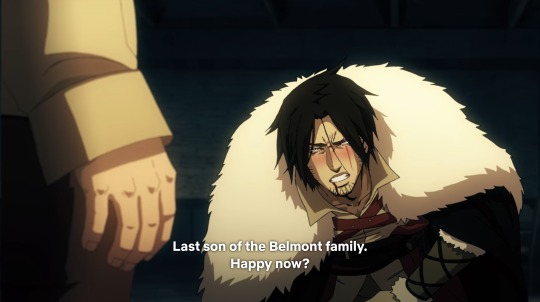
All right, truth time: The first time I watched the series, I didn’t have the subtitles on and between Armitage’s accent and the character groaning in pain, it took me a moment to register Trevor said ‘last son.’ Cause I first misheard the line as ‘bastard son.’ Which was a possibility in my head. Game of Thrones was still popular at the time this came out, so it wouldn’t have been too much of a stretch for Netflix Castlevania to try to make bank on a knock-off Jon Snow character. I mean, look at Trevor. Ragged hair, fur cloak, total Night’s Watch.
Historically, though, this still would have been a valid take on Trevor’s character. The Wallachian laws of succession, at least with the reigning family, did not abide by the feudal law of primogeniture like most western Medieval countries. So the eldest son was not necessarily guaranteed the father’s position and wealth. All the sons, even the illegitimate ones, had a shot at succeeding the father. I’m not sure if this practice extended to the lower aristocracy or even the peasantry (any sources I find are frustratingly vague), but it would surprise me if this wasn’t the case. It would be odd for one social class to have different inheritance practices than another. (Then again, this is the aristocracy...) Not to mention a lot of folktales from the area do have the theme where a father with multiple sons sets some task for the boys to prove their worth or something similar.
If this were the case, it could’ve been an interesting explanation of why Trevor was the only survivor of the massacre. Being an illegitimate child would have made him a potential target for his father’s wife if she wanted to ‘clear out’ the competition for her own sons, so it’s plausible he could have fled the house and simply wasn’t there at the time of the mob’s attack.
In all, it’s a headcanon I sometimes think about. In the video games, there’s no mention of Trevor’s parents outside of the Lords of Shadow branch of the franchise, which isn’t considered part of the canon timeline. Trevor mentions his parents only once in the series, saying he’d seen drawings of the Cross Haladie in his mother’s books and that his father once got into a fight with a Speaker. Which...fisticuffs or was this Speaker capable of Sypha levels of combat?
#castlevania#trevor belmont#belmont family#trevor belmont parents#wallachian politics and the history lesson no one asked for#Medieval Wallachia#wallachian social classes#medieval europe#lords of shadow#castlevania netflix#game of thrones#night's watch
12 notes
·
View notes
Photo
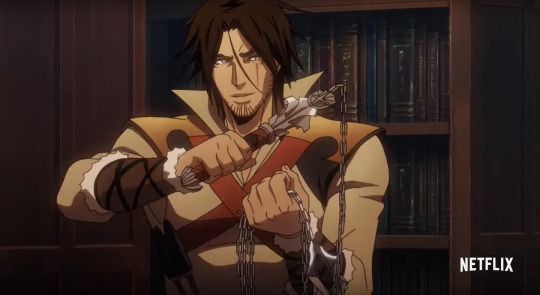
Brief Character Analysis
Like many medieval territories, Wallachia’s people were divided up into rigid social classes: the aristocracy, made up of the voivode ruler and the boyar lords; the clergy, the Catholics and Eastern Orthodox being the most prominent; and the peasantry, made up mostly of the free landowners, merchants, serfs, etc. All the way back in the first couple episodes, House Belmont is named as one of the ‘great houses’ or ‘great families’ and ‘their lands were taken’ after the excommunication. Given that, the family crest, and the size of the ruined estate, Trevor was likely born into one of the highest and most privileged classes in the region. And while this doesn’t necessarily show in his manner of speech (because he’s not exactly the most well-spoken character in the series,) we can see that status in how he sometimes acts.
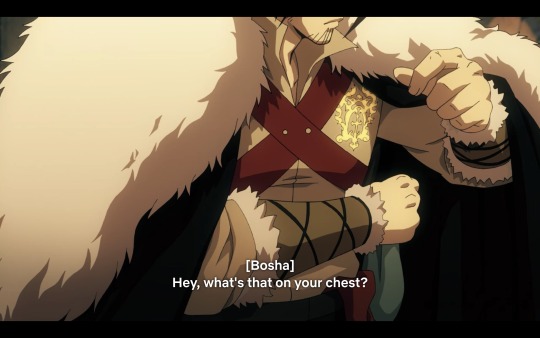
He still wears his family’s crest, although keeping it mostly hidden, even though it draws attention and often lands him in trouble.
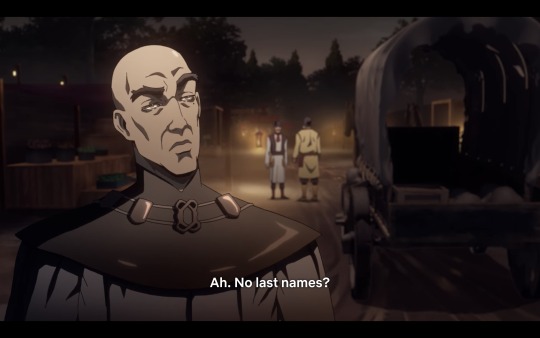

When someone asks his name, he either gives his real name or he refuses to answer altogether.

Or he’s just trolling people.
The point is, he could easily wear unmarked clothing, he could easily assume a different name. The fact he does neither is very admirable familial pride and the creators did a beautiful job of showing, despite his usual apathetic demeanor, how important his identity and family is to him.
#castlevania netflix#trevor belmont#belmont family#castlevania#character analysis#historical context#medieval history#medieval romania#medieval wallachia#wallachian social classes
27 notes
·
View notes